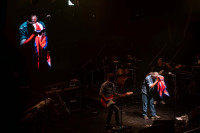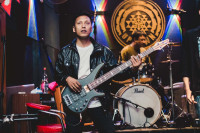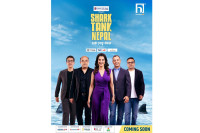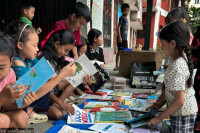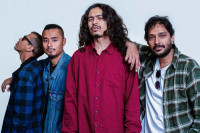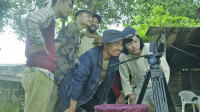Entertainment
A Sea of Pain: in Kochi
Sea of Pain will probably be the most talked about piece at the latest edition of the Kochi-Muziris Biennale (KMB 2016) of India.
Kurchi Dasgupta
Sea of Pain will probably be the most talked about piece at the latest edition of the Kochi-Muziris Biennale (KMB 2016) of India. One encounters it at one corner of the main venue (the biennale is spread across twelve locations), at the historic Aspinwall House that stands on the sea. Sudarshan Shetty, an artist of stellar repute and a guest curator for this edition of the Biennale, revealed that he selected this particular project as the first of all others. What had struck him about the Chilean poet Raul Zurita’s project was the ‘honesty of intention’.
Zurita happens to be one of Latin America’s most controversial and celebrated poets, whose poems sprung from a position of resistance to the dictatorial regime that the Chileans lived through (1973-1990). I believe the KMB piece is in a way a continuation of what Zurita did in the Atacama Desert in 1993, when he bulldozed the last four words of the last poem of his book La Vida Nueva across two miles of desert sand in Chile. It reads as ‘neither pain nor fear’. In his 2009 preface to his first book of poems, titled Purgatory, Zurita tellingly writes: ‘When faced with the horror, we had to respond with art that was vaster and stronger than the pain that was inflicted on us,’ and later, ‘in a more benign world, art would no longer be necessary.’
Sea of Pain is a large piece, but not on the scale of the desert writing. The ground floor of one entire warehouse is flooded with knee-high sea water and viewers are invited to wade through it and read the text on eight canvas panels (700 x 340 cm each) hanging on the adjoining walls. The text moves through the staccato and haunting ‘Never? Never? Never?’...’Never?’... ‘Won’t you come back? Never again?’ through ‘Don’t you listen? Don’t you look?’ to the end panel that bears a poem written in memory of Galip Kurdi, who has gone down in history as ‘the brother of Alan Kurdi, the three-year old boy whose body washed ashore a beach on the September 2, 2015, his image becoming synonymous with the refugee crisis.’ Shetty shared the initial misgivings the curatorial team had about showcasing a work that so obviously mined the sentiments, and one whose relevance was so momentous that it might easily fall back into the facile. They were also apprehensive of the public’s willingness to participate in an installation that was meant to turn into individual, experiential performances. For only if you waded through the 100 feet or so long stretch of water would you be able to read the final text and then again, one would have to wade back. Their apprehension was obviously unfounded, for when I encountered the piece, it was full of mirthful visitors splashing to and from the far panel that read:
‘The Sea of Pain
For Galip Kurdi
Alan Kurdi was three and his photograph circled the world.
He lay face down and the blue red of his clothes was striking
in its strange tidiness on the shore. Hours later the Turkish
coast guards recuperated the bodies of his mother and small
Five-year old brother, Galip, but of him there are no photographs.
....
... I wasn’t there,
I am not his father.
There are no photographs of Galip Kurdi, he can’t hear, he can’t
see, he can’t feel, and the silence comes down like immense
white cloths.
Below the silence you can make out a piece of sea, of the sea
of pain. I am not his father, but Galip Kurdi is my son.
The image of Alan Kurdi’s dead body has haunted us across cultures. Shetty is right when he says that Zurita was playing out his personal memory and experience of pain through this work, as he does with all his poems, and the work succeeds not because it moves us as we do the wading in the water—the stretch is long enough to make one feel inevitably helpless on the way back—or reading the texts that come across as intertitles in a silent film. The individual’s response or reflection is only part of the intended effect. The work strikes home only when you pause to watch the crowds, enjoying the refreshing dip after a round of no-doubt demanding biennale viewing, mostly oblivious to the texts’ portent. It comes across as a visual and performative metaphor for the world’s response to the refugee crisis. It instigates and investigates our response to, or rather lack of it, to the predicament of people who have lost their homes and lives through no fault of their own. Coming from Nepal, it was difficult to not connect it to the world’s very similar response to the trauma habitually experienced by Nepali migrant labour.
The manner in which the wall texts revealed the underlying narrative, coupled with the viewers’ verbalised responses, reminds me of the experience I recently had while watching Chaplin’s City Lights in Kathmandu. The silent dialogues, explained through intertitles, came alive through viewers’ response. The missing element of human voice was compensated for through viewers’ responses, their laughter and cries. The success of Sea of Pain hinges on the same viewers’ response, and a reflexive perception of it.
KMB 2016 is envisioned on the fulcrum of ‘multiplicity’ that is encapsulated in the biennale’s theme: ‘forming in the pupil of an eye’, which draws on the imagery of an entire universe reflected back from a sage’s eye to a disciple. It queries into the various means of knowledge production and whether and how such production must remain open to continuous interpretation and refreshed communication. And whether it is possible for
objects as multiple occurrences to occupy this space as an inclusive experience. Sea of Pain may easily be accepted as a metaphor for this overarching theme. It is a work that will undoubtedly stay in public memory for a long time, if for wildly differing reasons. After all, this is not a benign world, and so art is necessary.




 23.31°C Kathmandu
23.31°C Kathmandu
